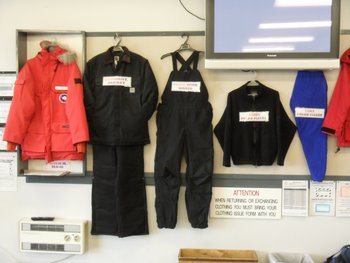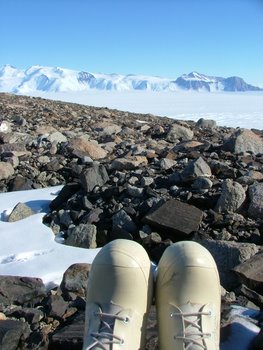"Antarctica: It's a Harsh Continent", so the popular saying says. This phrase can be heard and seen everywhere down here. About half of the time, people say it in jest; but, when the weather turns bad, they mean it. There are bumper stickers for sale with phrase, and when the credit card machine at the McMurdo store broke down, there was an apology note on the door reminding everyone that Antarctica is, indeed, a harsh continent.
Antarctica is the world's highest, driest, and windiest continent. While I've been here, I've not seen her true nature. Everywhere I go, everyone comments on how they've never seen such nice weather for this length of time. At any minute, the weather is destined to turn. Now, our nice weather has disappeared. We woke this morning to fog and overcast skies. By the end of breakfast, it had begun to snow and blow. We never did get much snow, but there are little, fluffy drifts in the nooks and crannies of the rocks. The temperature has been in the low 20s (Fahrenheit) today with the wind chill in the low teens. And, for the first time since I've been here, I'm cold.

When we hiked to the summit of Mt. Hope, and took the scenic detour home, I got a little dehydrated. I developed a slight headache, and by the time I'd reached camp, the wind had come up and I was chilled. Ever since then, I haven't quite been able to shake the chill. I spent the day drinking lots of hot chocolate, spiced cider, and lemon-ginger tea. I finally bundled up, placed toe warmers in my socks, a stick-on body warmer to my stomach, and crawled into my -40F sleeping bag. After a two hour nap, I awoke finally feeling warm again.
So, how do we stay warm enough down here? There are three things required: food, liquids, and proper clothing. Your body cannot function unless it has fuel to burn. In order to stay warm and have enough energy for the long (sometimes 12-13 hours), strenuous days, we eat lots and lots of food, much of it high in calories. Your body cannot burn all of this fuel without water. We carry thermoses full of hot water with us so that on breaks we can have soup and other hot beverages. In the cold, the last thing you really feel like drinking is cold water, so the hot drinks entice us to keep hydrated. Finally, it's important to have the proper clothing and to wear it in layers.
The Clothing Distribution Center (CDC(abbreviation) Clothing Distribution Center (or Centre as they spell it in New Zealand)) in Christchurch made sure we had the proper cold weather clothing, and lots of it. There's a trick to keeping warm in all this clothing, though. The first trick is to always wear layers of clothing made of the correct materials. The second trick is to make sure they're dry.

Clothing that will help you stay warm and dry are made of wool, polypropylene, polar fleece, or silk. These materials wick (draw) moisture away from your body. Cotton clothing down here, or anywhere that is cold for that matter, is a huge "no-no". Once cotton gets wet, it takes a very long time to dry out and the moisture stays next to your skin. So, the first thing that does on is long underwear. The CDC(abbreviation) Clothing Distribution Center (or Centre as they spell it in New Zealand) gave us two weights: mid-weight and expedition weight. I also brought three pair of my own - all mid-weight. Then, depending on how cold it is, comes fleece pants and shirts/jackets. The CDC(abbreviation) Clothing Distribution Center (or Centre as they spell it in New Zealand) gave one pair of pants and a jacket both of which are fairly heavy weight. I also brought a lighter pair of fleece pants and three fleece shirts. The outer layer consists of bibbed wind pants and a choice of coats: a lighter weight wind jacket or the -40F rated down parka. Most of the time I've been here, I've worn the light weight wind jacket.

For your feet, the first layer is a pair of thermal liners. These are light weight socks that wick moisture away from your feet. Over these go heavy wool socks. For boots, I have two choices, the Sorel snow boots I brought from home, or the CDC(abbreviation) Clothing Distribution Center (or Centre as they spell it in New Zealand) issued "bunny" boots. While in the field I've always worn my Sorels. They are so much more comfortable, easier to walk in, and they don't cause your feet to get as sweaty. I've only worn the "bunny" boots when required: "Happy Camper" school and on plane/helicopter flights. The "bunny" boots are rated down to -40F and have a valve on the side that allows a layer of air in between the rubber for insulation. When you're flying you have to make sure these valves are open, or else the boots become uncomfortably tight with expanding air.

For hands, we have four different types of gloves and a pair of leather mittens with wool liners. We have two pair of glove liners, a pair of polar fleece leather work gloves, and a pair of heavy insulated ski gloves. Most of the time I've been fine with only the glove liners on; but, when the wind comes up the leather work gloves keep my hands the warmest while still allowing for dexterity. Down here, you almost never take off your hat. You even sleep in it. We were issued two types of head gear. We have a red windproof Yazoo cap which is lined with polar fleece and has two long ear flaps that fasten on top of your head, or it it is cold, velcro under your chin. (If you read the journal entry for December 31st, you'll see Perry wearing one.) I brought my PolarTREC fleece hat which I've usually been warm enough in. We've also been given a wind-stopper balaclava that covers your nose and mouth and allows your face to stay warm with only minimal fogging of your glasses. For our necks we have a thick polar fleece neck gaiter (tubular scarf that you pull over your head). The purpose of dressing in layers is so as you warm up, you can take layers off. The key is to not overheat and sweat. Any moisture, even though the materials are wicking, will accelerate the rate at which you cool off. Some of the first things to come off are your hat, gloves, and neck gaitor. Then, as your activity level increases, you start taking clothing off your torso or core. Once you begin to cool down, the layers go back on in the same order. In the evening, when you go to bed, any clothing that is damp gets hung up in the top of the tent (only if it is sunny and warmish) to dry. If there is no sun and it is colder, then the clothing goes into the sleeping bag with you to dry and keep from freezing. To maintain your body warmth (and keep it all from going into warming the sleeping bag) you sleep in your long underwear and hat. I usually have quite a bit of clothing in my sleeping bag with me, so any clothing I have to wear tomorrow is placed under my head during the night. I wake up about half an hour before I need to get up and place my clothing for the day inside the sleeping bag to warm up before I put it on.
Being cold just those couple of days has made me begin to appreciate what the early explorers experienced. I still cannot begin to imagine the extreme temperatures and winds they experienced. They did not have the luxury of air flight and had to use dogs, ponies, or man-haul all their own gear. They didn't have the support that would allow them to remain in place should they experience severe weather. They had to continue on through blizzards, high winds, and extreme sub-freezing temperatures. They certainly didn't have modern fabrics to keep them dry and warm. My respect for those heroic explorers has increased enormously.
I haven't seen the harsh continent of Antarctica, but having slept on the ground for three weeks with only a sleeping bag or the fire of a Coleman stove to provide warmth, I've learned to appreciate our modern conveniences. I know that with just a short helicopter or plane flight, I can quickly return to a warm and protective environment. One, which I can now say, I'm beginning to look forward to.


Comments